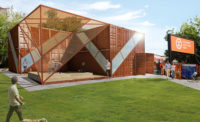Now Shipping to a Site Near You: Cargo Container Offices

Cargo Container Offices
c3600, a Seattle project by HyBrid Architecture, features a green roof and walls, above-ground water retention, and other sustainable features. Even with these sometimes pricey systems, constructing the 7,200-square-foot commercial showroom and offices will cost 20 to 40 percent less than a conventional project, according to the architecture firm. Cargo containers account for the savings. Crews hoisted into place all 12 boxes in just four hours on June 18.
Image courtesy HyBrid Architecture

Cargo Container Offices
c3600, a Seattle project by HyBrid Architecture, features a green roof and walls, above-ground water retention, and other sustainable features. Even with these sometimes pricey systems, constructing the 7,200-square-foot commercial showroom and offices will cost 20 to 40 percent less than a conventional project, according to the architecture firm. Cargo containers account for the savings. Crews hoisted into place all 12 boxes in just four hours on June 18.
Image courtesy HyBrid Architecture

Cargo Container Offices
c3600, a Seattle project by HyBrid Architecture, features a green roof and walls, above-ground water retention, and other sustainable features. Even with these sometimes pricey systems, constructing the 7,200-square-foot commercial showroom and offices will cost 20 to 40 percent less than a conventional project, according to the architecture firm. Cargo containers account for the savings. Crews hoisted into place all 12 boxes in just four hours on June 18.
Image courtesy HyBrid Architecture

Cargo Container Offices
c3600, a Seattle project by HyBrid Architecture, features a green roof and walls, above-ground water retention, and other sustainable features. Even with these sometimes pricey systems, constructing the 7,200-square-foot commercial showroom and offices will cost 20 to 40 percent less than a conventional project, according to the architecture firm. Cargo containers account for the savings. Crews hoisted into place all 12 boxes in just four hours on June 18.
Image courtesy HyBrid Architecture

Cargo Container Offices
c3600, a Seattle project by HyBrid Architecture, features a green roof and walls, above-ground water retention, and other sustainable features. Even with these sometimes pricey systems, constructing the 7,200-square-foot commercial showroom and offices will cost 20 to 40 percent less than a conventional project, according to the architecture firm. Cargo containers account for the savings. Crews hoisted into place all 12 boxes in just four hours on June 18.
Image courtesy HyBrid Architecture

Cargo Container Offices
c3600, a Seattle project by HyBrid Architecture, features a green roof and walls, above-ground water retention, and other sustainable features. Even with these sometimes pricey systems, constructing the 7,200-square-foot commercial showroom and offices will cost 20 to 40 percent less than a conventional project, according to the architecture firm. Cargo containers account for the savings. Crews hoisted into place all 12 boxes in just four hours on June 18.
Image courtesy HyBrid Architecture

Cargo Container Offices
c3600, a Seattle project by HyBrid Architecture, features a green roof and walls, above-ground water retention, and other sustainable features. Even with these sometimes pricey systems, constructing the 7,200-square-foot commercial showroom and offices will cost 20 to 40 percent less than a conventional project, according to the architecture firm. Cargo containers account for the savings. Crews hoisted into place all 12 boxes in just four hours on June 18.
Image courtesy HyBrid Architecture

Cargo Container Offices
c3600, a Seattle project by HyBrid Architecture, features a green roof and walls, above-ground water retention, and other sustainable features. Even with these sometimes pricey systems, constructing the 7,200-square-foot commercial showroom and offices will cost 20 to 40 percent less than a conventional project, according to the architecture firm. Cargo containers account for the savings. Crews hoisted into place all 12 boxes in just four hours on June 18.
Image courtesy HyBrid Architecture

Cargo Container Offices
c3600, a Seattle project by HyBrid Architecture, features a green roof and walls, above-ground water retention, and other sustainable features. Even with these sometimes pricey systems, constructing the 7,200-square-foot commercial showroom and offices will cost 20 to 40 percent less than a conventional project, according to the architecture firm. Cargo containers account for the savings. Crews hoisted into place all 12 boxes in just four hours on June 18.
Image courtesy HyBrid Architecture

Cargo Container Offices
c3600, a Seattle project by HyBrid Architecture, features a green roof and walls, above-ground water retention, and other sustainable features. Even with these sometimes pricey systems, constructing the 7,200-square-foot commercial showroom and offices will cost 20 to 40 percent less than a conventional project, according to the architecture firm. Cargo containers account for the savings. Crews hoisted into place all 12 boxes in just four hours on June 18.
Image courtesy HyBrid Architecture

Cargo Container Offices
c3600, a Seattle project by HyBrid Architecture, features a green roof and walls, above-ground water retention, and other sustainable features. Even with these sometimes pricey systems, constructing the 7,200-square-foot commercial showroom and offices will cost 20 to 40 percent less than a conventional project, according to the architecture firm. Cargo containers account for the savings. Crews hoisted into place all 12 boxes in just four hours on June 18.
Image courtesy HyBrid Architecture




Post a comment to this article
Report Abusive Comment